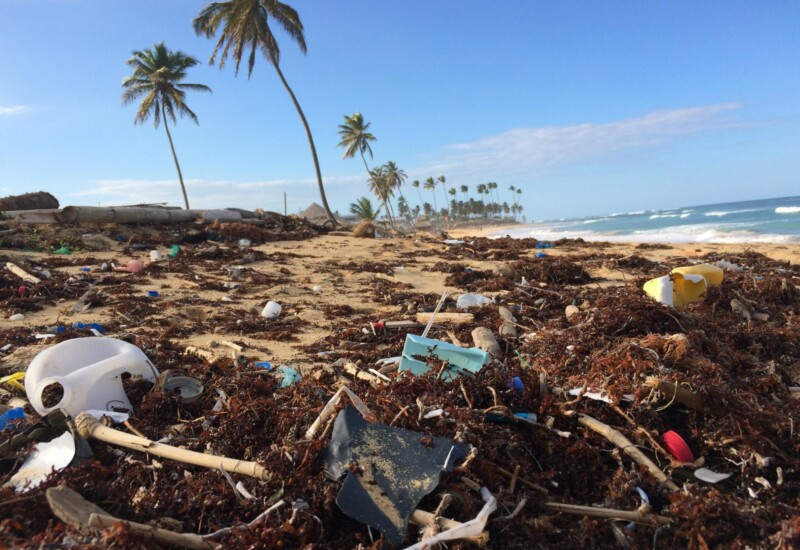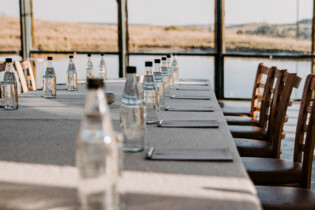In events, single-use or disposable plastics have been especially useful in offering convenience, speed, scale, hygiene and affordability. Think of an event with thousands of attendees, and how quickly and safely they can be catered for with pre-packaged meals, disposable cutlery in sterile packaging, and disposable coffee cups (made from paper, but lined in plastic so that your cup doesn’t get soggy).
These are some of the reasons why ‘fantastic plastic’, until recently, has been so successful. However, mass sentiment towards this material has turned overwhelmingly negative, especially as it relates to single use plastic products, thanks in a large part due to David Attenborough’s The Blue Planet II. This documentary highlights the environmental havoc that plastic waste can cause, such as:
- Plastic can take hundreds of years to decompose. During this time, there is a high risk it will not be disposed of responsibly and will become litter. Bird and marine life mistake it for food, with fatal consequences.
- When it does break down, it breaks into tiny pieces called microplastics. These are now found everywhere, including in our digestive tracts.
- A few plastics contain chemicals which are harmful to our health. BPA is a well-known example. Plastic pollution releases these chemicals into our ecosystems.
- Many, but not all, plastics can be recycled. Recycling presents a good way to keep this resource in our value chain and out of natural systems.
- However plastic cannot be recycled indefinitely, as the process degrades the quality of the final product; all plastic becomes waste in the end.
While plastic is an incredibly useful resource, especially in certain applications such as healthcare, we need to start being far more mindful of how we use it. And in this regard, single-use plastics that are designed to be thrown away after a very brief use period are no longer acceptable.
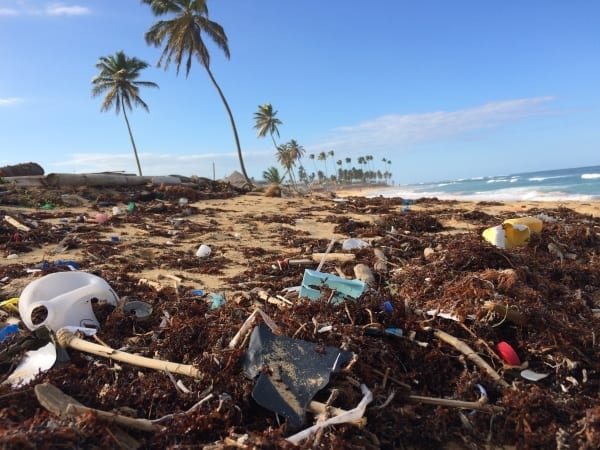
So what can we do?
Luckily, there is a lot we can do to stop this problem from growing.
“The first question we should always ask is whether we can avoid disposable items,” says Greg McManus, the Chairperson of the Event Greening Forum. “As a rule of thumb, re-usables are always the more sustainable option.”
This could include serving food with re-usable cutlery and crockery and linen serviettes, or using sealed containers to hold pre-prepared food in. Greg acknowledges that while this is comparatively inconvenient, by tweaking systems and processes it is often easily do-able. Many music festivals now issue re-usable plastic cups. (Yes, plastic! But its resilience makes it the best choice here.) A deposit system ensures most of them are returned at the end of the event, so they can be washed and re-used at the next one. Sometimes the cups are branded and become take-home mementos.
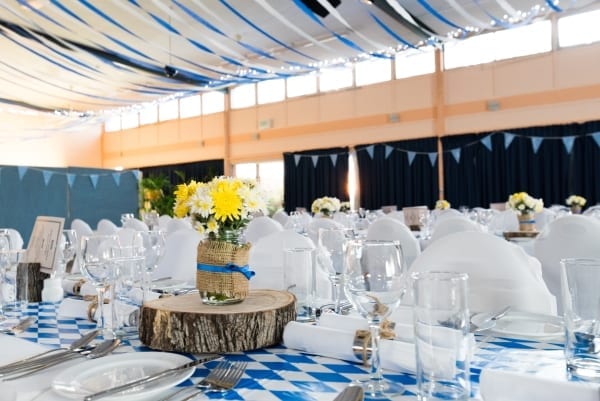
When re-use simply isn’t feasible, there are a number of alternatives to plastic that have gained popularity. These include bioplastics – the best known one being Polylactic acid (PLA), bagasse, paper, and even wood. These materials all come from renewable sources (plants) and are compostable, which means they can break down into nutrition for the soil and not leave any toxins behind (see: Biodegradable vs compostable).
They promise all the benefits of disposability with none of the environmental hazards. However, it’s important you understand their limitations so that if you use them, you do so as sustainably as possible – so read on.
| Material | Commonly used for | Derived from | Advantages | Disadvantages | Disposal |
| Bioplastic such as Polylactic acid (PLA) | Replaces PET bottles, PS trays and lids, PP and PS cutlery, and the lining in paper coffee cups | Plant starch – usually corn, but cassava, sugarcane or sugar beet pulp have also been used | Behaves very much like plastic – can be moulded, is durable & food safe | Easily confused with plastic but not recyclable | Commercial composting |
| Bagasse | A good alternative to polystyrene, it’s used to create moulded takeaway food containers, cups & bowls | Sugarcane pulp | Made with the byproduct of sugar manufacturing Heat tolerant – can go in the freezer and microwave Can hold liquids & greasy products | Can be confused with paper, but isn’t recyclable Contains fluorinated compounds which do not biodegrade, so will contaminate any compost | Commercial composting |
| Paper | Packets or wrapping for food like sandwiches, muffins & pies | Wood or recycled paper | Low cost Ideal for composting as it adds carbon to the compost | Cannot handle wet foods People often don’t realise that paper contaminated with food cannot be recycled | Commercial composting |
| Wood | Coffee stirrers, cutlery, think ‘plates’ | Fast growing bamboo & birch trees | Can be FSC apporved | Trees are not as quickly renewable as other plants All bamboo products are imported into SA | Commercial composting |
But, there is a ‘but’…
Just because something is compostable, doesn’t mean it will become compost. It needs the right conditions, including oxygen, warmth, moisture and microbes. If it ends up in landfill or the ocean where these conditions are missing, it simply won’t compost. PLA, for example, will effectively behave like plastic if it isn’t composted correctly, and can harm wildlife in the same way as plastic.
Therefore, if you decide to use any of these at your event, you need to set up a clearly marked compost waste stream for them and all other organic waste, such as food scraps and leftovers. Some venues have onsite composting you can back into, but if not you can bring in a solution for your event. Earth Probiotic, for example, provides an on-site event food waste composting service.
Secondly, these materials are not easily compostable. They must be sent to industrial composting facilities where the composting temperatures exceed 60°C. Even in these conditions, compostable plastics can take 80 to 180 days to completely break down, and bagasse 45 to 60 days. Home composting simply will not work – despite some suppliers claiming it can.
Gavin Heron, the Director of Earth Probiotic, likes to shred this material first. This extra step increases the surface area of the waste stream and exposes a greater volume to compost microbes and heat, to help speed up the process. In Earth Probiotic’s Earth Cycler, this means it can take between 10 to 14 days.
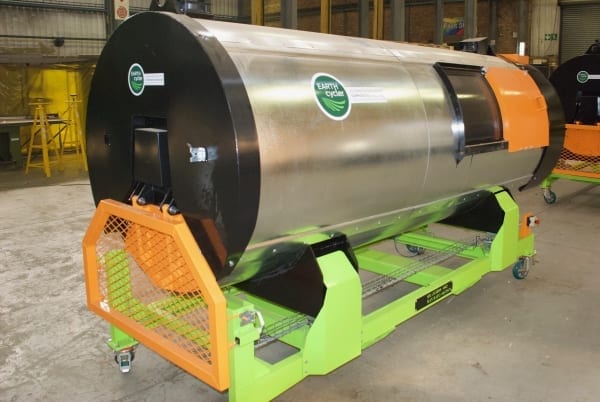
Melanie Ludwig, the founder of Zero to Landfill Organics, shares another important consideration to bear in mind: Some products claiming to be compostable do not meet the accepted composting parameters. She will only accept products at her composting facility that are certified compostable – and registered on the Biodegradable Products Institute, DinCertco (Germany) or TUV Austria certification databases – to ensure she isn’t jeopardising the quality of her compost. Every certified product should have the conformity logo and the certification number printed on it. These numbers can be used to trace each product back to the manufacturer on the certification website, helping ensure transparency and accountability.
It is unlikely you will be able to find BPI certified bagasse products from 2020. This is due to the discovery it contains fluorinated compounds, which bioaccumulate and will contaminate any compost made from it.
When looking for a supplier, always request compostability certifications for their products and make sure they are marked with a conformity logo.

But wait, there’s more
There is a further challenge that needs to be addressed. PLA is so similar to plastic in terms of its appearance and properties that it is effectively impossible for humans to differentiate between the two. This means that it is very easy – and likely – that consumers with the best intentions will throw it into plastic recycling bins. This is problematic.
“We ask our clients not to send us biodegradable and compostable plastics as it’s very bad if they are mixed with recyclable plastics when they go to a plastics plant – they can ruin a batch,” says Carmen Jordaan, the Director of Whole Earth Recycling.
Annabé Pretrorius from Plastix 911 adds, “In Europe, infrared scanners are used to identify the various material streams. In South Africa, with our high unemployment rate, we rather use people to identify the various incoming waste streams. Compostable plastic is very difficult to identify on a conveyor.”
The only way to recognise PLA compostable plastics is through the labelling, she says; “Proper PLA should carry the material identification code 7 with ‘PLA’ underneath.” Unfortunately, not all PLA products on the market come with this labelling.
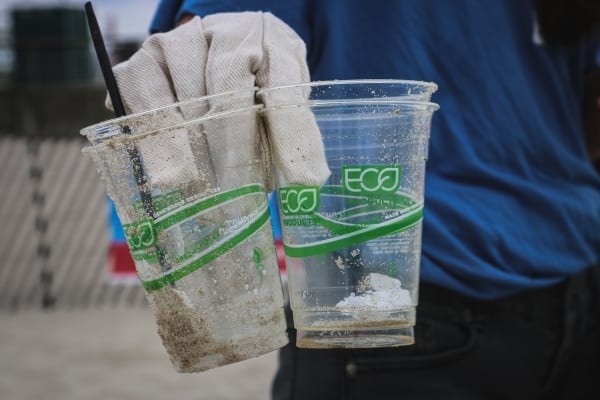
Bagasse and food paper packaging also risk being discarded with paper recycling. If this happens and they have been used for food, they will reduce the recyclability of the paper waste because they will contaminate it. It’s not as serious a problem as PLA getting into the recycling, but it is another factor to bear in mind.
Where does that leave us?
Gavin’s advice is simple; “Because it is very difficult to distinguish between PLA and normal plastic, one needs to have an all or nothing strategy. If, for example, a conference has both types of material at the event, then none of the material should be composted.” This is because of the difficulty and cost of separating plastic out of the compost waste stream, and compostable plastics into it, and the risks of contamination.
If you don’t think you can effectively remove all single use plastics and manage composting at your event, rather focus on sourcing and using plastic items that can and will be recycled. Confirm with your waste management company exactly which ones these are. (Of course, you can still compost any organic food waste in this scenario.)
You should also make an effort to reduce your event’s waste. “Single-use plastics like most people think of it, straws and cutlery, to name two of them, should not be given out willy-nilly,” says Annabé. “The consumer should have to ask for it. And if I ask for a serviette and a fork, don’t give me a complete set in a plastic bag with salt, pepper and a toothpick!”
Regardless of which waste system you end up going with, it’s critical that it is clearly sign-posted, conveniently located, and easy to understand and use. One way to ensure waste bins are used correctly is to have waste ambassadors who can assist people while also educating them.
“Event organisers and conference facilitators can play a huge role in educating consumers and creating an awareness around plastics usage and waste,” says Annabé. “The waste bins should all be in one area and manned – tell people to separate organic waste from paper, glass, aluminium and plastic waste. Arrange with a waste management company to collect the waste at the end of the function and tell delegates how much of each waste was collected and what happened to it. We need to create an awareness of how much we waste and where it goes. Once people realise that, they will start to think about their own households and how they deal with waste.”
Biodegradable vs compostable
Biodegradable and compostable are not the same thing, despite sometimes being used interchangeably. Biodegradable means a material will break down in natural conditions. This can take a long period of time, and the end-result could include toxins. Compostable means a material will break down into nutrients for the soil (compost) under the right conditions. This will happen within a specific time frame, and there will be no remaining toxic residues.
All compostable items are biodegradable, but not all biodegradable items can be composted.
Industrial composting
The following facilities in SA can compost PLA & bagasse:
- Earth Probiotic – https://www.earthprobiotic.co.za/
- Enviroserv – https://www.enviroserv.co.za
- Reliance – https://www.reliance.co.za/
- Turfnet – https://www.turfgreen.co.za/
- Y Waste – https://www.ywaste.co.za/
- Zero to Landfill Organics – http://www.ztlorganics.co.za/
Useful resources
- Biodegradable Products Institute – https://www.bpiworld.org/
- Break Free From Plastics – https://www.breakfreefromplastic.org/reports/ (The ‘Better Alternatives Now B.A.N. List’ report includes a case study on how bioplastics behave in nature on page 14)
- Din Certco (Germany) – https://www.dincertco.de/en/dincertco/home.jsp
- European Bioplastics – https://www.european-bioplastics.org/
- Organics Recycling Association of South Africa – https://orasa.org.za/
- TUV Austria OK Compost – http://www.tuv-at.be/ok-compost/
Article supplied by the Event Greening Forum.


